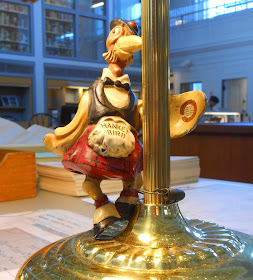 Soon after the publication of And to Think that I Saw it on Mulberry Street in 1937, Ted Geisel '25 (a.k.a. Dr. Seuss) produced a new creation for a very different audience: the Hankey Bird. This grotesque, drunken bird was designed to hang on the neck of a bottle of Hankey Bannister Scotch whiskey inviting you to have a drink.
Soon after the publication of And to Think that I Saw it on Mulberry Street in 1937, Ted Geisel '25 (a.k.a. Dr. Seuss) produced a new creation for a very different audience: the Hankey Bird. This grotesque, drunken bird was designed to hang on the neck of a bottle of Hankey Bannister Scotch whiskey inviting you to have a drink.If it seems odd to you, it did to Geisel as well. "There's no sense to it," he said in Sales Magazine (January 1, 1939):
"The bird on the bottle is a replica of an actual bird, developed after years of painstaking cross-breeding in the Seuss Laboratories for a lofty purpose, namely, to produce a carrier pigeon for the Scottish army... a bird so distinctive that it would not be mistaken for a grouse and shot down by near-sighted American millionaires. After fifteen generations of wearing kilts, the Hankey Bird has developed sideburns. But most unfortunately his mating call is characterized by a distinct burr. Our only purpose in leasing him to Hankey Bannister is to finance further scientific effort to de-burr that mating call... not, I assure you, to aid in the crass business of selling whiskey."We really should have a bottle to go along with our bird. We wrote to Hankey Bannister asking if they had an old bottle (preferably still full) that they could give us, but they did not have any samples.
To see it yourself, ask for MS-1100, Box 3.
No comments:
Post a Comment